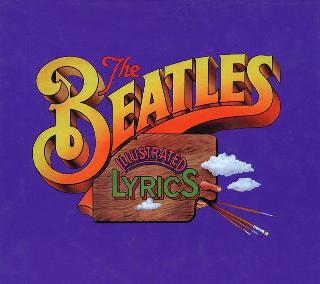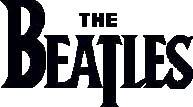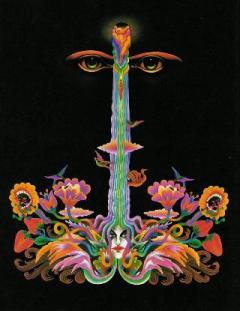

 (c) Alan Aldrigde, The Beatles Illustrated Lyrics
(c) Alan Aldrigde, The Beatles Illustrated LyricsGENERAL POINTS OF INTEREST
- Some things would appear to never change:
- Nevertheless, this group of covers *is* different in some respects from the ones we've seen in the past:
SONG-BY-SONG WALKTHROUGH
KEY A Major
METER 4/4
FORM
------ 4X ------ Intro -> Refrain -> Verse -> Outro (complete ending)
COMPOSER Berry
INFLUENTIAL VERSION Chuck Berry (1957)
- Within this batch of six covers, this was clearly the "longest running" number, still hanging in there at the bitter end of their touring days. Along with "Twist and Shout", it is one of a very small number of *non* original songs which might be described nonetheless as one of the group's emblematic "anthems". Curiously though, this particular Chuck song appears to have not been on the playlist of the Quarrymen era in spite of the fact that they were already playing back then the likes of "Roll Over Beethoven", "Johnny B. Goode", and "Sweet Little Sixteen".
- While the harmonic material of this song is limited entirely to the familiar I-IV-V of the blues, the formal schema used in both refrain and verse are more flexible here than the rigid 12-bar formula we're so used to finding in Berry's other songs. The refrain comes close to the 8+4 sub-species of the 12-bar form, though a petit-reprise-like repetition of the final half-phrase ("if you wanna dance with me") rounds the section out to an unusual fourteen measures. The verse is only eight measures long and harmonically opens *and* closes on the V chord.
- The Beatles version follows the formal outline of the original, but both the arrangement and John's vocal peformance suggest a harder- driven interpretation of the song rather than a stylized impersonation. Once having gotten used to the Beatles version as the default, I find myself a bit "surprised" to rediscover how much more melodic and layed back the original sounds in comparison.
- Beyond this, the two versions differ in a matter of some details. For example, Chuck played it in the lower key of E (or is it E-flat -- the CD re-issue from MCA is mastered at what sounds like off-speed), and there is some variation in the scanning of the words (e.g. "*PI*an*O* versus "pi*AN*o"). Note too how Chuck cues himself with a I chord at the beginning, whereas the Beatles sensibly change this to V.
KEY F# Major (yep, that's right!)
METER 4/4
FORM Intro -> Verse (initial) -> Verse (variant) -> Verse (half solo, half vocal) -> Verse (variant) -> Outro (fadeout)
COMPOSER Johnson
INFLUENTIAL VERSION Dr. Feelgood (1962)
- Judging from the introductory vocal scream you'd be tempted to suppose that John had a hankering to play the good Doctor that was as long-lived as Paul's desire to be Little Richard. It turns out that this song was not at all an "oldie" at the time the Beatles picked up on it and they didn't even keep it in their repertoire for all that long!
- Seems like this is *the* Beatles cover which everyone loves to hate; it must be something about the self-consciously campy vocal, lugubrious Hammond organ, and generally queasy blend of dooh-whop and Latin musical styles. But get beyond this if you can and discover a number of compositional details which are more reminiscent of the Beatles' own style than you'd ever expect from the surface.
- Some examples --
- The first section is based on a subtly different form from the rest of them. The relatively long verses all sub-divide into two halves, the second of which is always introduced by a rising scale played solo by the bass guitar, and if you bother to check, the first half of the first one is quite different (and eight measures longer than) the all the rest.
- The harmonic rhythm is very slow and contains many cases where the same chord is sustained for 2 or 4 measures or even longer, and the overall result is that the poetic scanning of the phrases sound less four-square than they actually are.
- The half instrumental solo and half vocal division of the middle section is a favorite, granted not original with them, device of the Beatles seen in such places as "From Me To You" and "A Hard Day's Night"."
- As with "Rock and Roll Music", the original version turns out to be less extremely inflected than the Beatles cover of it. One of the strangest variances is in the choice of key, the original having been in G. I can't honestly figure what would have influenced the Boys to do it in the *very* unusual key of F# Major, unless the half-step difference was just sufficient to keep John from cracking on the high notes. Still, I'd assume they must have fingered it in an easier key like E or F and used some capos.
KEY G Major
METER 4/4
FORM
KC------------------------------>|HHHH------------------->
- 2X - - 4X -
Intro -> Verse -> Verse (solo) -> Verse (fadeout)
COMPOSERS Lieber/Stoller - Penniman
INFLUENTIAL VERSION Little Richard (1959)
- Here we have the inevitable song, actually two of them spliced together, in which every section is in straight 12-bar (8+4 or AAB) blues form. Though recorded originally as two separate songs, Little Richard himself had already popularized the "medley" performed here by the Beatles. Independent of Paul's Penniman fixation, it's easy to imagine that the antiphonal backing vocals of the second half would have been something to attract the Beatles toward this number.
- For all its apparent simplicity, this turns out to be one of the more re-worked items in this set of six cover songs. Paul reverses the lyrics to the first two verses; perhaps an oversight more than anything else. But Little Richard saves the instrumental section (played on his version by a saxaphone instead of guitar) until after the first "hey hey" section has been sung. Along the same lines, we find that the original contains a complete ending instead of the Beatles' fadeout; very strange considering the large number of other cover songs with fadeouts on the original version changed to a complete ending by the Beatles.
- Both versions are performed in the same key though. As is the case concerning John versus Chuck, we find here that Paul's vocal sounds a bit strained and affected compared to the original. The Beatles make a small but persuasive chord change at the end of the first verse; changing measure 12 to the V chord (instead of sustaining the I chord from measure 11), all the better to motivate the next section.
KEY A Major
METER 4/4
FORM
- 2X - ---- 2X --- - 2X -
Intro -> Verse -> Verse (solo) -> Verse -> Outro (fadeout)
COMPOSER Holly
INFLUENTIAL VERSION Buddy Holly (1957)
- Strange, isn't it, given the extent to which the group can be said to have been influenced and inspired by the nice fellow from Lubbock, that this is the only one of his tunes to have become part of the official Beatles songbook, especially considering the relatively large number of his tunes that had been in their early repertoire, starting as early as the infamous Quarrymen acetate of "That'll Be The Day".
- The form is "monotonous" in the manner of Chuck's blues numbers though the sections here are all eight, instead of twelve, measures long. The harmonic content is an ostinato/mantra-like endless repetition of the I-IV-V chord progression, and the two-fold instrumental solo section is an unusual touch.
- Buddy's original is a tad more Latin in its backbeat, but the choice of key, as well as much of the guitar work, is identical in both versions. Granted, the Beatles do greatly emphasize their own open-fifth style of vocal counterpoint in the arrangement, plus they add hand claps and Ringo's banging on a "packing case" to the percussion section. But still, it remains essentially a sentimental and nostalgic Tribute To Buddy, rather than an outright imitation.
KEY E Major
METER 4/4
FORM
------- 2X -----
Intro-> Verse -> Refrain -> Verse (solo) -> Refrain ->
Verse -> Refrain -> Verse (solo) -> Refrain ->
Outro (complete ending)
COMPOSER Perkins
INFLUENTIAL VERSION Carl Perkins (1956)
- Forget about Buddy and Berry :-). Clearly, our Boys had some kind of Carl Perkins fixation. Surprisingly, he scores -- together with Larry Williams, of all people -- the highest number of songs by a single artist to have been covered by the Beatles on their official releases!
- Once you recover from your initial shocked surprise, it's worthwhile acknowledging the extent to which Perkins' "rock'a'billy" style rounds out the repertoire of a group that at the time was in transition toward "Rubber Soul" by way of "For Sale". From a different perspective, you can even argue that Carl's penchant for surprising, enigmatic lyrical turns of phrase ("sometimes you say you will when you won't "/"got that sand all over your feet") would also intruige the Beatles, especially John.
- This specific song didn't come into the act until as late as '62, but it stayed there as the default Ringo song on stage, for a while. Personally, I always find John's rendition (as heard on a pair of Beeb radio appearances) the more knowing and trenchant.
- For a fellow like Perkins whose output otherwise focuses around 12-bar formats, this one is a bit unusual. Granted, the refrains here are in the straight blues form, but the 12-bar verses incororpate a rather Buddy-esque use of the flat-VI chord, and the guitar solo sections are actually a clever 8-bar contraction of the verses in which the eighth measure moves to V instead of sustaining the flat-VI from the previous measure.
- Compared to the tidiness of the typical Beatles original composition, the repeat and alternation pattern sections of this one is relatively cranked out seeingly at random. Note especially the multiple solos and their asymmetrical placement. Faced with a similar gameplan back in "Matchbox" , the ever-fastidious Fab Four had taken the trouble to "reorganize" the song for increased tightness.
- Those who are primarily familiar with the Beatles version will likely be surprised by the extent to which it matches the original, right down to the same key, form, basic arrangement including the solo guitar work. Perkin's original vocal delivery though is unique and would not easily imitated; especially by Ringo.
KEY E Major
METER 4/4
FORM
- 2X - ------ 2X -----
Intro -> Verse -> Verse (solo) -> Verse -> Verse (solo) ->
- 2X -
Verse -> Outro (complete ending)
COMPOSER Perkins
INFLUENTIAL VERSION Carl Perkins (1958)
- Yet another Perkins song, dropped out of the repertoire during '63 only to return for '64 and '65, likely in order to give George a solo vocal with which to fill the gap between "Roll Over Beethoven" and "If I Needed Someone," the poor guy.
- This one sports the familiar Perkins signature of a lengthy form with unusual repeat patterns and multiple sections for instrumental solo. In contrast to "Honey Don't", this time every section is in the classic 12-bar blues mold. Indeed, the 4+8 inner structure of each frame obviates the need for a separate refrain since the longer second half of each section provides its functional equivalent.
- The Beatles opt for a thick, muddy sounding instrumental backing that makes Perkins' original look primitive and homespun in comparison. The choice of key and form though match up with the original.
SOME FINAL THOUGHTS
- The following chart, derived from data published in Lewisohn's "Live" book, provides some insight into the historical layering of the Beatles cover repertoire. The data below covers only the six songs under discussion in this article, but I'd suggest the same technique *should* be applied to their entire catalog; volunteers ? :-)
'57-'59 '60 '61 '62 '63 '64 '65 '66 #years
Every X X X X || 4
Honey X X X X || 4
Kansas X X X || 3
Mister X X || 2
Rock X X X X X X X || 7
Words X X X X || 4
====== ====== ====== ====== ====== ====== ====== ====== ======
#songs 1 2 4 6 3 4 3 1
Some observations:
- Our six songs entered and exited their repertoire on a staggered basis over the course of their entire stage career, with all six appearing only in the '62 season. With the exception of "Mr. Moonlight", all of these songs were adopted by the Beatles at least a year or more later than the original appeared.
- The persistence of two-to-three of these songs in the continually shrinking list of songs the Beatles would play live as the group ground toward their last couple seasons as a touring band is striking in light of the expected trend toward original material. It's also interesting too to see how the four cover songs current during '64 are evenly divided among the foursome in terms of who is the lead vocalist.
- Three of these six covers were dropped out during the busy '63 season, though two of them paradoxically were returned to the lineup in '64. Even stranger, and likely indicative of their scrambling to fill out the album, is the inclusion on the album of two songs which were *not* part of the live lineup any more as of '64; indeed, was it nostalgia or desperation ?
- The earliest included song of the six, "Words Of Love", was also the first one to be dropped out. And quite appropriately, "Rock and Roll Music" was fated to be the longest running!
Regards,
Alan (awp@bitstream.com *OR* uunet!huxley!awp)
---
"Will you still need me, will you still feed me ?" 080592#64
---